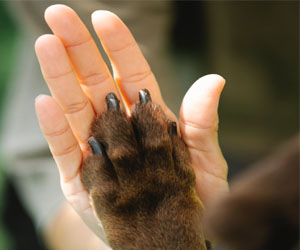


What Your Feline Friend Is Telling You

Cats are known for their mysterious and expressive body language, and one of the most telling aspects of their non-verbal communication is their tail. A cat's tail is like a barometer of their emotions, offering valuable insights into their state of mind. In this article, we'll explore the fascinating world of cat tail language and what your feline friend might be trying to convey.
1. Straight Up And Quivering: When a cat's tail is held high and quivering at the tip, it's typically a sign of excitement and anticipation. Your cat may be thrilled to see you, play, or receive a treat.
2. Puffed Up And Arched: A puffed-up tail, similar to a bottlebrush, is a classic sign of a frightened or threatened cat. It's an attempt to make themselves appear larger and more intimidating.
3. Straight Up And Fluffed: When a cat's tail is held high and fluffed, it indicates that they are feeling defensive or agitated. This often occurs when they encounter a perceived threat.
4. Low And Tucked Between Legs: A cat tucking its tail between its legs is a clear sign of fear or submission. It's an attempt to make themselves appear smaller and less threatening.
5. Slow Side-To-Side Swishing: A tail swishing slowly from side to side is a sign of a cat's irritation or annoyance. It's a warning sign that they may become agitated if the source of their annoyance continues.
6. Rapid Side-To-Side Swishing: A tail swishing rapidly from side to side often signifies that a cat is highly agitated and potentially aggressive. This is a clear signal to back off and give the cat space.
7. Tail Wrapped Around Another Cat Or Object: Cats will wrap their tails around other cats, objects, or even their humans as a sign of affection and friendship. It's a gesture of closeness and connection.
8. Curled Around Body: A cat that curls its tail around its body while resting is generally in a content and relaxed state. They feel safe and comfortable in their environment.
9. Lashing Tail: A lashing or thrashing tail is a strong sign of a cat's frustration, anger, or overstimulation. It's often seen in cats during play when they become too excited.
10. Twitching Tip: A twitching tail tip can signify curiosity or intense focus. Cats may do this when observing prey, a toy, or something intriguing.
11. Slow Wagging Tail: A slow, deliberate wag of the tail often indicates a cat's mild annoyance or impatience. It's a signal to pay attention to their cues.
12. Tail Held Low And Straight: A cat with its tail held low and straight may be signaling submission, especially when accompanied by other signs of fear or stress.
Understanding cat tail language is an essential skill for any cat owner. It allows you to gauge your cat's mood and respond appropriately to their needs. It's crucial to consider the context of the tail position and any other accompanying body language to interpret your cat's emotions accurately.
Remember that each cat is an individual, and while tail language is a valuable indicator, it should be considered alongside other cues like ear position, body posture, and vocalizations. With time and observation, you'll become increasingly skilled at understanding your cat's tail language, strengthening the bond between you and your feline companion.


Building A Strong Foundation Of Trust And Communication
 Building Trust: Obedience training is about more than just teaching your dog to respond to commands. It's about building trust and a strong bond between you and your pet. When a dog learns to follow your cues and understands that you will provide clear guidance, they develop a sense of trust in your leadership.
Building Trust: Obedience training is about more than just teaching your dog to respond to commands. It's about building trust and a strong bond between you and your pet. When a dog learns to follow your cues and understands that you will provide clear guidance, they develop a sense of trust in your leadership.
Effective Communication: Training your dog to obey commands is essentially teaching them a common language. This effective communication is a two-way street, as it not only involves giving commands but also understanding your dog's body language and cues. By learning to interpret your dog's signals and respond appropriately, you strengthen your bond and prevent misunderstandings.
Basic Commands: Obedience training typically covers essential commands, such as sit, stay, come, down, and heel. These commands are not just about control; they are safety measures. A well-trained dog is less likely to engage in dangerous behavior, ensuring their safety and that of others.






A Timeless Connection Of Love And Loyalty
 A History Of Companionship: The history of the human-dog bond is a rich tapestry of cooperation and companionship. Dogs were among the first animals to be domesticated by humans, dating back thousands of years. Initially, dogs were utilized for hunting and protection, but over time, their roles expanded to include herding, guarding, and eventually becoming cherished family pets. This evolution of the dog's role in human society laid the foundation for the extraordinary bond we share today.
A History Of Companionship: The history of the human-dog bond is a rich tapestry of cooperation and companionship. Dogs were among the first animals to be domesticated by humans, dating back thousands of years. Initially, dogs were utilized for hunting and protection, but over time, their roles expanded to include herding, guarding, and eventually becoming cherished family pets. This evolution of the dog's role in human society laid the foundation for the extraordinary bond we share today.
Factors That Strengthen The Bond:
Trust And Loyalty: Dogs are renowned for their unwavering loyalty. This trust and devotion between dogs and their owners build a strong foundation for the human-dog bond. The reliability of a dog's presence and affection creates a deep sense of security for their human counterparts.
Communication: Dogs are incredibly adept at understanding human body language, vocal cues, and emotions. This exceptional ability to communicate effectively with humans fosters a sense of mutual understanding and connection.
Emotional Support: Dogs offer comfort and emotional support in times of distress. Their empathetic nature allows them to sense when their owners are upset, providing a source of solace and companionship.
Physical Touch: The simple act of petting and cuddling with a dog releases oxytocin, the "love hormone," in both the dog and the human. This physical touch is a significant factor in strengthening the bond.
Shared Experiences: Whether it's going for a walk, playing fetch, or simply sitting together, the shared experiences between humans and dogs create lasting memories and reinforce the bond.
Unraveling The Enigmatic Feline Nature
 2. Communication Through Body Language: Cats are skilled communicators, and their body language speaks volumes. Pay attention to their tail, ears, and whiskers, as these are indicators of their current mood. For example, a flicking tail may signify annoyance, while a content cat typically holds its tail upright.
2. Communication Through Body Language: Cats are skilled communicators, and their body language speaks volumes. Pay attention to their tail, ears, and whiskers, as these are indicators of their current mood. For example, a flicking tail may signify annoyance, while a content cat typically holds its tail upright.
3. The Language Of Purring: One of the most intriguing aspects of cat behavior is purring. Cats purr for various reasons: contentment, comfort, and even as a self-soothing mechanism. Understanding the context and accompanying body language can provide insights into the purpose of their purring.
4. Instinctual Behaviors: Cats retain many of their wild instincts, including hunting and territorial marking. Scratching furniture and kneading are instinctual behaviors, and providing outlets for these urges, like scratching posts, is crucial for a happy indoor cat.
5. The Night Owl Nature: Cats are crepuscular animals, which means they are most active during dawn and dusk. This natural behavior may explain why your cat seems most playful and energetic during these times. Creating a stimulating evening routine can help channel their energy positively.
6. Play Is Serious Business: Play is not just a source of entertainment for cats; it's also a way for them to hone their hunting skills. Engage your cat in interactive play with toys that mimic prey, which can satisfy their instincts and provide exercise.
7. Socialization And Territory: Cats are territorial animals. They may be wary of unfamiliar cats or even new people in their home. Proper socialization early in life and gradual introductions to new situations can help reduce stress and ensure a contented cat.
Paving The Way To A Sustainable Future
 Understanding The Climate Crisis: The climate crisis, characterized by rising global temperatures, is driven primarily by human activities, including the burning of fossil fuels, deforestation, and industrial processes. Its consequences, such as extreme weather events, sea-level rise, and ecological disruptions, pose serious threats to our environment, economies, and societies.
Understanding The Climate Crisis: The climate crisis, characterized by rising global temperatures, is driven primarily by human activities, including the burning of fossil fuels, deforestation, and industrial processes. Its consequences, such as extreme weather events, sea-level rise, and ecological disruptions, pose serious threats to our environment, economies, and societies.
Importance Of Climate Action: Climate action is paramount because the consequences of inaction are dire. Failing to address the climate crisis jeopardizes food security, water resources, public health, and the stability of ecosystems. Moreover, it deepens global inequality and exacerbates social and economic disparities.
Key Climate Action Strategies:
Transition To Clean Energy: One of the most critical climate action strategies is transitioning from fossil fuels to clean, renewable energy sources. Solar, wind, hydropower, and geothermal energy provide sustainable alternatives to carbon-intensive fuels. This transition reduces emissions and bolsters energy independence.
Energy Efficiency: Enhancing energy efficiency is a cost-effective strategy for reducing greenhouse gas emissions. Implementing energy-efficient technologies and practices in industries, transportation, and residential buildings minimizes energy waste.
Reforestation And Afforestation: Forests play a crucial role in carbon sequestration. Reforestation (replanting trees in deforested areas) and afforestation (planting trees in new areas) help absorb carbon dioxide from the atmosphere and restore ecosystems.
Hypnosis For Phobia Treatment
 Hypnosis, characterized by a state of deep relaxation and heightened suggestibility, offers a unique means of addressing phobias by tapping into the subconscious mind. During a hypnotherapy session, individuals are guided into a trance-like state where their minds become more receptive to suggestions. This heightened suggestibility allows the hypnotherapist to work with the individual to reframe their thoughts and feelings related to the phobia.
Hypnosis, characterized by a state of deep relaxation and heightened suggestibility, offers a unique means of addressing phobias by tapping into the subconscious mind. During a hypnotherapy session, individuals are guided into a trance-like state where their minds become more receptive to suggestions. This heightened suggestibility allows the hypnotherapist to work with the individual to reframe their thoughts and feelings related to the phobia.
Here's how hypnosis can play a crucial role in phobia treatment:
Accessing The Subconscious: Many phobias are rooted in the subconscious mind and linked to past experiences or traumas. Hypnosis can help individuals access these subconscious memories and feelings, allowing them to understand the root causes of their phobia.
Reprogramming Beliefs: Hypnotherapy enables individuals to challenge and reframe the negative beliefs and thought patterns associated with their phobia. By introducing positive and calming suggestions, the hypnotherapist can help individuals alter their emotional response to the feared object or situation.
Desensitization: Hypnosis can be used to gradually desensitize individuals to the phobic stimulus. In a trance-like state, individuals can mentally rehearse confronting their fear, becoming increasingly comfortable with the idea of facing it in reality.
Relaxation And Anxiety Reduction: Phobias often trigger intense anxiety and panic. Hypnotherapy is particularly effective in promoting relaxation and reducing anxiety, enabling individuals to approach their phobia with greater calmness and confidence.
Paving The Path To A Sustainable Future
 3. Carbon Pricing And Taxes
3. Carbon Pricing And Taxes
Carbon pricing mechanisms, such as carbon taxes and cap-and-trade systems, place a price on carbon emissions. By making carbon-intensive activities more expensive, these policies encourage individuals and businesses to reduce their carbon footprint. This, in turn, motivates a shift away from fossil fuel consumption.
4. Electrification Of Transportation
The electrification of transportation is another key strategy for reducing fossil fuel usage. Electric vehicles (EVs) are becoming increasingly popular as their technology improves and charging infrastructure expands. Shifting from gasoline and diesel-powered vehicles to EVs helps decrease the demand for fossil fuels in the transportation sector.
5. Investments In Public Transportation
Investments in public transportation systems can also contribute to fossil fuel reduction. Well-developed public transit networks make it easier for people to rely less on personal vehicles, thus decreasing the demand for gasoline and diesel fuels.
6. Sustainable Land Use And Urban Planning
Sustainable land use and urban planning focus on designing cities and communities that reduce the need for long commutes and encourage walking, biking, or the use of public transportation. This approach lowers fossil fuel consumption associated with daily commuting.
7. Research And Development
Investing in research and development is critical for the creation of cleaner and more efficient technologies.